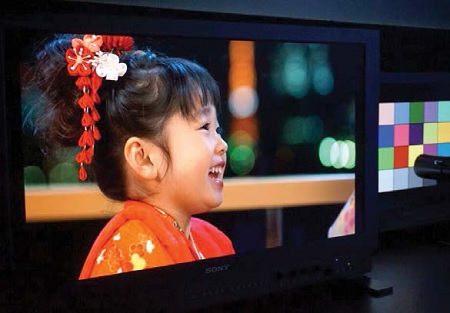Company 3 Prepares for Future With Sony’s BVM-X300
LOS ANGELES—The past decade has been a nightmare if, like me, your work revolves around reference monitor technology. Now, the long search for a replacement to CRT reference monitors has come to an end with the arrival of Sony’s BVM-X300 30-inch master monitor.
At Company 3, a postproduction company based in Santa Monica, Calif., the BVM-X300 is set to replace our fleet of beloved BVMD24s, as we expect BVM OLED technology will play an important role in production in the years ahead, with advancements in HDR, 4K and BT.2020 color space.
Over the years, we’ve remained vigilant, testing new technologies—LCD, plasma, and OLED—waiting patiently for something that can truly take the place of the CRT. The BVMX300 is the first non-CRT that has gained the confidence of our color professionals. After months of testing it, we are preparing to make it our standard.

The BVM-X300 is a 30-inch monitor with 4K, HDR and BT.2020 capabilities.TECHNOLOGY LIMITATIONS
To see what’s so impressive about it, let me put it in the context of these other technologies. First, LCDs have been useless for us, mostly because of viewing angle deficiencies. Having a single colorist looking dead-on while working in isolation might work, but we have several people looking at the same monitor in a collaborative, creative effort. Even the best LCD produces a different image at a different angle. The last thing you want in a color grading bay is people arguing over what they’re seeing.
Plasma has been of limited utility. Clients like to see a bigger image on something color-matched with our 24-inch BVM-D24s, so the plasma monitors have had a place. But this technology is fading from the market.
Now the OLED BVM-X300 is ready for the most demanding applications for a reference monitor. Since this transition is very serious for us, we have been thorough in evaluating the product. The monitor is consistent across viewing angles and has excellent uniformity overall. It is solid, robust and stable enough to replace the CRT.
MORE THAN A REPLACEMENT
The monitor’s added capabilities make it much more than a replacement; it is an upgrade that enables 4K and HDR production and opens the door to the emerging BT.2020 color space.
The professional video industry's #1 source for news, trends and product and tech information. Sign up below.
While 4K gets most of the attention, HDR gets our clients riled up. In addition to revealing detail in the highlights, HDR provides vivid realism many viewers associate with 4K resolution in a 2K environment. The need for HDR capability is the final “nail-in-the-coffin” for the CRT.
The BVM-X300 also enables our increasingly distributed workflow. We gather people in our offices around the globe for grading sessions, but this only works if we’re confident in the calibration and uniformity of each monitor. Sony’s new OLED technology will ease that task since calibration is less involved and more stable.
How the BVM-X300 clears the way for the BT.2020 color space is also important for those investing in a reference monitor. As far as I know, there’s nothing on the market now that covers the recently adopted BT.2020 color space in full, but this is a workable solution that covers most of it.
As much as we’ve loved them, reference-grade CRTs are fading; we’ve been running though a half-dozen CRTs per year for repair and replacement and the available number left is shrinking fast. The industry is at a point of decision. After our rigorous testing, we believe that the decision is clear.
Mike Chiado is senior vice president engineering/image science at Company 3, which provides high-end post production, color grading and location services for feature films, commercials, music videos and television. He can be contacted atMike.Chiado@company3.com.
For more information, visitwww.sony.com/professionalor call 201-930-1000.
